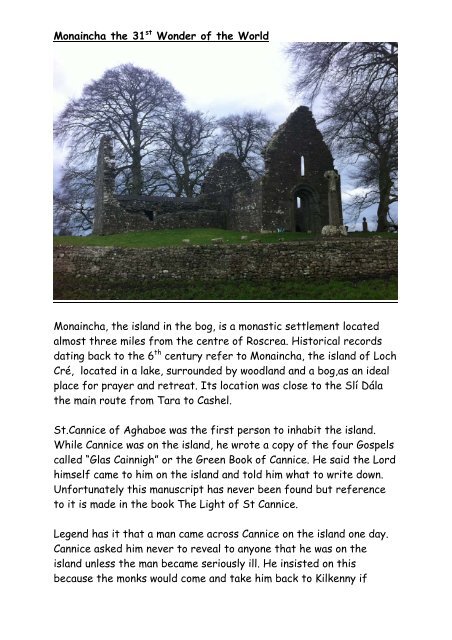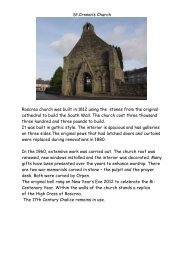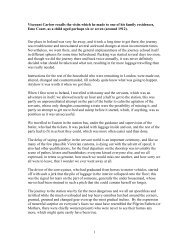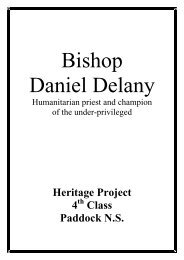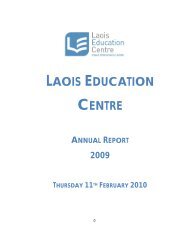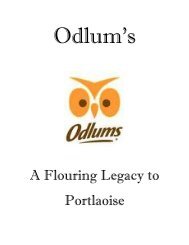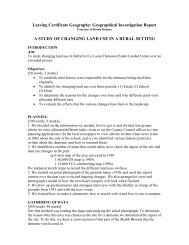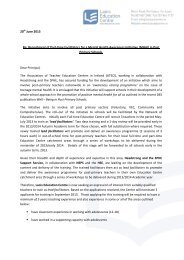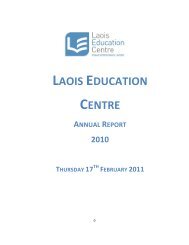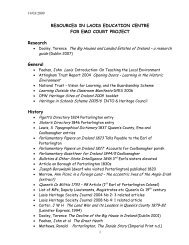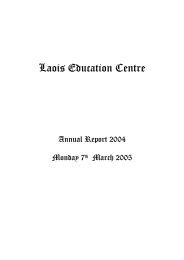Monaincha the 31st Wonder of the World - Laois education Centre
Monaincha the 31st Wonder of the World - Laois education Centre
Monaincha the 31st Wonder of the World - Laois education Centre
Create successful ePaper yourself
Turn your PDF publications into a flip-book with our unique Google optimized e-Paper software.
<strong>Monaincha</strong> <strong>the</strong> 31 st <strong>Wonder</strong> <strong>of</strong> <strong>the</strong> <strong>World</strong><br />
<strong>Monaincha</strong>, <strong>the</strong> island in <strong>the</strong> bog, is a monastic settlement located<br />
almost three miles from <strong>the</strong> centre <strong>of</strong> Roscrea. Historical records<br />
dating back to <strong>the</strong> 6 th century refer to <strong>Monaincha</strong>, <strong>the</strong> island <strong>of</strong> Loch<br />
Cré, located in a lake, surrounded by woodland and a bog,as an ideal<br />
place for prayer and retreat. Its location was close to <strong>the</strong> Slí Dála<br />
<strong>the</strong> main route from Tara to Cashel.<br />
St.Cannice <strong>of</strong> Aghaboe was <strong>the</strong> first person to inhabit <strong>the</strong> island.<br />
While Cannice was on <strong>the</strong> island, he wrote a copy <strong>of</strong> <strong>the</strong> four Gospels<br />
called “Glas Cainnigh” or <strong>the</strong> Green Book <strong>of</strong> Cannice. He said <strong>the</strong> Lord<br />
himself came to him on <strong>the</strong> island and told him what to write down.<br />
Unfortunately this manuscript has never been found but reference<br />
to it is made in <strong>the</strong> book The Light <strong>of</strong> St Cannice.<br />
Legend has it that a man came across Cannice on <strong>the</strong> island one day.<br />
Cannice asked him never to reveal to anyone that he was on <strong>the</strong><br />
island unless <strong>the</strong> man became seriously ill. He insisted on this<br />
because <strong>the</strong> monks would come and take him back to Kilkenny if
<strong>the</strong>y found him. Unfortunately <strong>the</strong> man did become ill so he told<br />
people about Cannice. The monks came from Kilkenny and took<br />
Cannice back to <strong>the</strong> monastery.<br />
Sometime after, when St.Cannice was visiting St.Columba on <strong>the</strong><br />
island <strong>of</strong> lona in Scotland, St.Columba asked him how he knew and<br />
understood <strong>the</strong> scriptures so well. St Cannice replied that <strong>the</strong> Lord<br />
came to him on <strong>the</strong> island <strong>of</strong> <strong>Monaincha</strong> and explained <strong>the</strong> scriptures<br />
to him in great detail. Following this <strong>the</strong> island became a famous<br />
place for prayer and retreat. In <strong>the</strong> 8th century <strong>the</strong> Culdee<br />
movement came to Roscrea under <strong>the</strong> leadership <strong>of</strong> <strong>the</strong> hermit Hilary.<br />
Hilary believed that <strong>the</strong>y should live a stricter lifestyle, so he moved<br />
out to <strong>Monaincha</strong>. Here <strong>the</strong>y lived a strict religious life. Hilary died<br />
in 807 and <strong>the</strong> Culdees were wiped out at <strong>the</strong> end <strong>of</strong> <strong>the</strong> Viking raids.<br />
However, <strong>the</strong> sanctity <strong>of</strong> <strong>the</strong> island remained. In <strong>the</strong> 12th century<br />
<strong>the</strong> Augustinian Canons came, and in 1190 The Hiberno-Romanesque<br />
Church was built.<br />
The build is a great example <strong>of</strong> an early 12th century church with a<br />
later addition. The nave and chancel are both 12th century but <strong>the</strong><br />
sacristy is a later addition featuring a gothic pointed arch. The<br />
sandstone doorway is highly ornate. The door is made up <strong>of</strong> four<br />
entwined archways each with <strong>the</strong>ir own intricate design. The<br />
windows in <strong>the</strong> nave are 13th century. There is a High Cross similar<br />
to <strong>the</strong> Roscrea Cross, located opposite to <strong>the</strong> doorway. The cross<br />
bears a clo<strong>the</strong>d figure <strong>of</strong> Christ. The base is possibly 10th century or<br />
earlier. The top half with <strong>the</strong> figure is 12th century and <strong>the</strong> shaft,<br />
in an attempt to preserve it, is 20th century cement!<br />
In <strong>the</strong> 17th century <strong>the</strong> island became internationally known for<br />
pilgrimage. It became more famous than Knock! During <strong>the</strong> 17th and<br />
18th century it was used as a church.<br />
The Birch Family bought <strong>Monaincha</strong> and <strong>the</strong> surrounding land in 1780.<br />
The <strong>Monaincha</strong> bog was drained in <strong>the</strong> 1800’s by <strong>the</strong> Birch Family.<br />
The lake disappeared. The island became a small mound built with <strong>the</strong><br />
remains <strong>of</strong> <strong>the</strong> dead. The surrounding area was used as a rifle range<br />
by <strong>the</strong> town garrison. When it was drained a pilgrim’s bottle was<br />
found. This is now housed in <strong>the</strong> National Museum.
In 1975 pilgrimage to <strong>the</strong> island was revived and in2000 <strong>Monaincha</strong><br />
was <strong>the</strong> focal point for Roscrea’s millennium pilgrimage.<br />
There are many legends and myths associated with <strong>the</strong> island. There<br />
is a cake <strong>of</strong> bread on <strong>the</strong> windowsill in <strong>the</strong> nave and three <strong>the</strong>ories to<br />
how it got <strong>the</strong>re:<br />
• It could have been <strong>the</strong> headgear on top <strong>of</strong> <strong>the</strong> High Cross.<br />
• Or it could be <strong>the</strong> top <strong>of</strong> a pillar.<br />
• And finally it could be a cake <strong>of</strong> bread because<br />
legend has it that a woman was baking a cake <strong>of</strong> bread while soldiers<br />
were attacking. The soldiers asked <strong>the</strong> woman where <strong>Monaincha</strong> was<br />
and instead <strong>of</strong> lying she told <strong>the</strong>m exactly where it was. So <strong>the</strong><br />
soldiers attacked <strong>Monaincha</strong> and as soon as <strong>the</strong>y did, <strong>the</strong> bread<br />
turned to stone.<br />
Women were not allowed on <strong>the</strong> island and an island close by became<br />
known as Nun’s Island. In <strong>the</strong> 14th century <strong>the</strong> Book <strong>of</strong> Ballymote<br />
described <strong>Monaincha</strong> as <strong>the</strong> <strong>31st</strong> <strong>Wonder</strong> <strong>of</strong> <strong>the</strong> <strong>World</strong>.<br />
Today<strong>Monaincha</strong> is a local tourist attraction maintained by <strong>the</strong><br />
Office <strong>of</strong> Public Works. Our local “wonder” is a legacy to <strong>the</strong> people<br />
<strong>of</strong> Roscrea and beyond.


